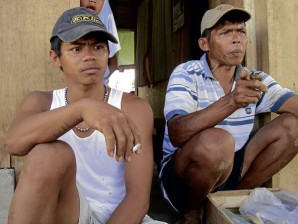DSWD project: More bunkhouse anomalies seen

ROMULO SEROT and his son, Remly, admit working on the construction of a bunkhouse by the Department of Social Welfare and Development (DSWD) but are surprised when they are informed that their signatures appeared on a liquidation sheet that showed they got paid more than they were. NICO ALCONABA / INQUIRER MINDANAO
COMPOSTELA, Compostela Valley—Borrowing carpentry tools from a friend, Romulo Serot worked on the first day of the building of one of two Department of Social Welfare and Development (DSWD)-funded bunkhouses on the grounds of the University of Southeastern Philippines here.
The day after, however, his friend had to take his tools back, leaving the 50-year old Serot with no choice but to not show up at the construction site.
With Serot out of work, his 23-year-old son Remly volunteered to replace his father, this time as a carpenter’s helper. He worked for three days before deciding to return to his old job as driver of a pedal-pushed tricycle.
A week after, Remly collected P600 as payment for his three-day job. He also received P300 for his father’s one-day work.
Last Saturday, however, the father and son were shocked to learn that they received a total of P8,400 for 12 days of work on the bunkhouse. Based on liquidation records of the DSWD, Romulo and Remly were paid P350 per day for 12 days.
Article continues after this advertisementBefore showing them a copy of the DSWD liquidation sheet, the Inquirer asked the Serots to sign on a piece of paper and compare these with signatures on the liquidation sheet. The result: Remly’s signature was similar to what was on the liquidation sheet. Romulo’s, however, was very different.
Article continues after this advertisementStill, Remly was certain that it was not his signature on the liquidation sheet. “I did not sign that,” he said.
Romulo kept asking: Who signed for his name and who took the money?
Remly admitted that he affixed his signature on a document, but not the liquidation sheet that the Inquirer showed him, when he collected his father’s P300 pay.
“I signed, yes, but I used my signature,” he said.
Romulo insisted that it was not his signature on the DSWD liquidation sheet.
“Besides, I will not claim that money because I did not work for it,” the elder Serot said. “But why would they use my name for them to earn money?” he said.
The case of the Serots indicate possible forgery and falsification of documents in the project. Romulo puts a theory forward: He said each bunkhouse did cost P550,000 “because maybe the amount included money for themselves (those behind the project).”
Romulo said if there were savings in the project, “they should have not pocketed it.”
“They should have used it in other projects for the typhoon victims,” he said.
The Serots are only two of the hundreds of workers who built 23 bunkhouses in Compostela Valley and Davao Oriental. Nico Alconaba, Inquirer Mindanao